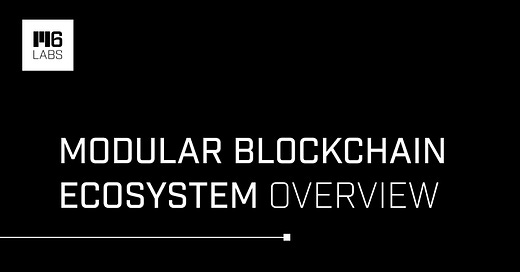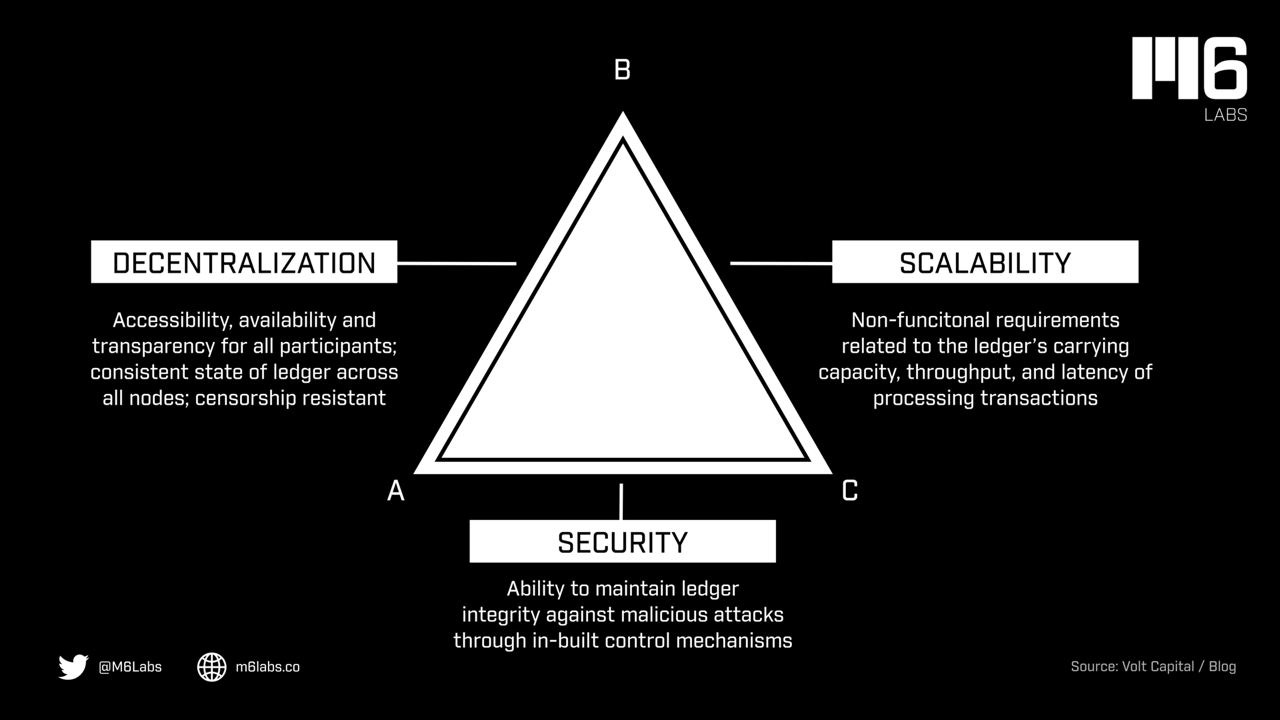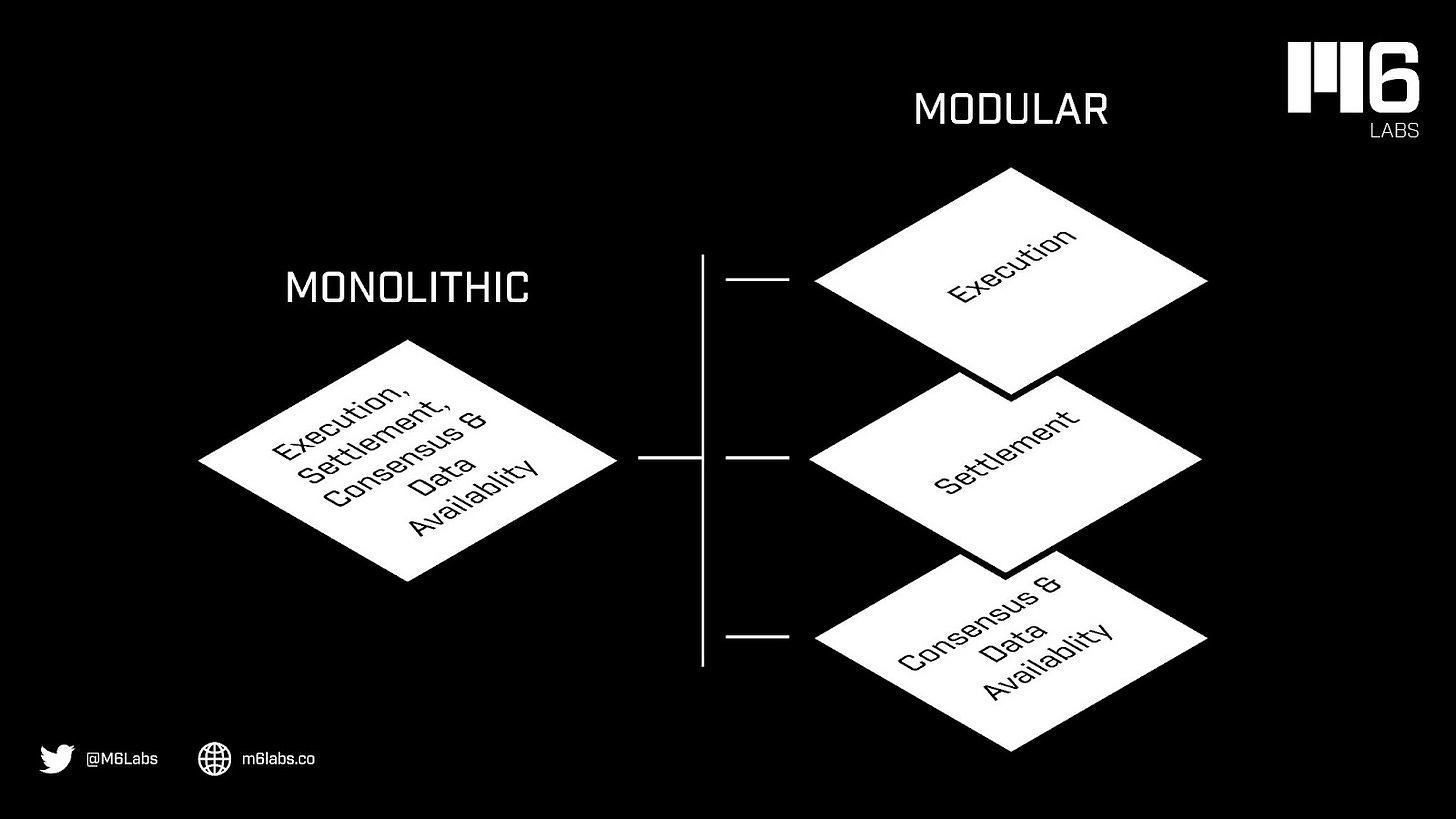Modular Blockchain Ecosystem Overview
Modular blockchain solutions like Celestia, Dymension, and Fuel give developers a wide range of options to not only scale blockchains but also enable cross-chain interoperability
Blockchains have evolved, with each iteration attempting to solve the blockchain trilemma of decentralization, scalability, and security. Blockchains such as Bitcoin, Ethereum, and Solana have a monolithic structure and four primary functions: data availability, consensus, settlement, and execution.
Because these functions compete for the same resources, monolithic blockchains will inevitably experience the following scalability issues.
Modular blockchain solutions like Celestia, Dymension, and Fuel give developers a wide range of options to not only scale blockchains but also enable cross-chain interoperability. The concept of building a modular blockchain is still very new, so it will be interesting to see what existing chains begin to take a similar approach.
The efficiency of modular blockchains has increased as they focus the validator set on shards which increases the blockchain's throughput. Here are a few advantages of modular blockchains:
Sovereignty
Scalability
Ease of building projects
Celestia
Celestia is focused on blockchain scaling and has already raised $55 million to fund its expansion plans. Celestia is creating a one-of-a-kind modular blockchain architecture to address scaling and deployment concerns.
Celestia's team intends to make blockchain deployment simple for everyone. As a result, Celestia's modular blockchain architecture prioritizes the following:
Improving scalability
Shared security
Sovereignty issues
Developers can select their execution environment with Solana VM and EVM as examples. Celestia also offers a fellowship for modular builders. They listed three blockchain projects as users of its data availability layer in its most recent funding announcement:
The project also provides a $3,000 monthly grant to 26 members of the "Modular Fellows Cohort" for three months. Scott Sunarto, who has worked for the Ethereum Foundation and Uniswap Labs, is among the recipients.
Celestia is still in the early stages of development. The development team released an MVP in 2021 and a devnet in November 2021. 2022 has been even more significant as the project has launched a testnet and has gradually been building the Mainnet.
Dymension
This modular settlement layer provides all the tools and infrastructure needed to launch enshrined rollups (rollup logic incorporated into the protocol) as part of the Cosmos ecosystem, which opens up decentralized use cases.
Dymension is a sovereign roll-up built on Cosmos that aims to make rollApp (custom application-focused rollup) development easy through the Dymension Chain (settlement layer), RDK (RollApp development kit), and IRC (inter-rollup communication). The Dymension chain is "aware" of rollups on top of it. It is optimized primarily for maintaining rollup states, proofs of verification, and fraud proofs while accepting only roll-up transactions and basic transfers.
Developers can focus on business logic needs and quickly deploy application-specific rollups using RDK and a specialized settlement layer while benefiting from IRC, shared security, and data availability. See our post below to learn more about data availability:
Dymension RollApps, like Cosmos, aim to create application-specific blockchains to reduce consensus overhead. Based on the Cosmos-SDK, the RDK adds new modules and modifies existing modules to ensure that RollApp is compatible with the Dymension protocol while being compatible with other Cosmos ecosystem tools. RollApps can communicate with any IBC-enabled chain via Dymension Hub.
Fuel Labs
Fuel Labs is building a fast execution layer for the modular blockchain stack. Fuel has enjoyed remarkable growth, as this project is known for being the home of some of the best engineers.
Fuel's technology stack is built on three pillars:
Parallel transaction execution: Fuel provides top processing capacity by executing transactions in parallel
Fuel Virtual Machine (FuelVM): the FuelVM increases design space for developers
Superior developer experience (with Sway and Forc): Fuel’s domain-specific language, Sway, provides a unique and sleek developer experience. Fuel also has a supportive toolchain known as Forc.
Fuel intends to be the driving force behind an autonomous future. Developers can build without the use of intermediaries. It provides modularity and an alternative to Ethereum's future. Ethereum is heading toward a rollup-centric end. Fuel claims it can expand the execution layer beyond standard rollups. The team claims they will do so without jeopardizing security and at a low cost.
Because Fuel was designed for fraud proofs, complete node resource requirements may be higher than usual, increasing bandwidth capacity while allowing users to verify the chain via trust-minimized light clients.
Benefits of modular blockchains
Scalability
A monolithic blockchain allows users to have all expected blockchain functions in a single layer known as Layer 1. This makes blockchain creation difficult because it attempts to handle all functions simultaneously within a single layer. The parts of a modular blockchain are shared among different layers, improving scalability and preventing network disruption.
Streamlined Blockchain Creation
To launch a new blockchain, miners must deal with security and decentralization issues, which may prevent some from optimizing the out-of-network hash rate (opportunity). When miners focus less on specific functions such as consensus, they can leverage the layout and create new blockchains more quickly, regardless of blockchain architecture.
Flexibility
The modular blockchain layout is significantly more flexible than the monolithic blockchain layout. It is intended to provide miners with features not available on a monolithic blockchain.
Conclusion
With the development of Layer 2s and rollups, the Ethereum ecosystem shifted toward a modular architecture. One of the biggest barriers to blockchain technology's mass adoption is scalability. Layer 1 scaling solutions focus on block production rather than block verification. The modular blockchain infrastructure aims to catalyze the adoption of Web 3 with scalability, security, and decentralization features and a focus on ease of integration, fast delivery, and user experience.
Subscribe to receive our daily brief, extended weekly newsletter, and in-house research content!
Please Share, Leave Feedback, and Follow Us on Twitter, Telegram, and LinkedIn to stay connected with us.








